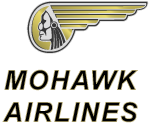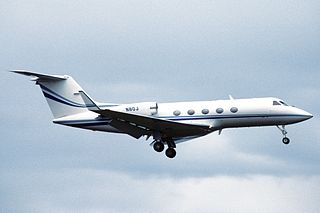Northwest Airlink was the brand name of Northwest Airlines' regional airline service, which flew turboprop and regional jet aircraft from Northwest's domestic hubs in Minneapolis, Detroit, and Memphis. Service was primarily to small-to-medium-sized cities and towns where larger aircraft might not be economical to operate and also to larger markets to either provide additional capacity or more frequent flights than could be justified using mainline aircraft. Beginning in July 2009, the Northwest Airlink trade name was phased out, and replaced by the Delta Connection trade name for Delta Air Lines as part of the Delta/Northwest merger.

Mohawk Airlines was a regional passenger airline operating in the Mid-Atlantic region of the United States, mainly in New York and Pennsylvania, from the mid-1940s until its acquisition by Allegheny Airlines in 1972. At its height, it employed over 2,200 personnel and pioneered several aspects of regional airline operations, including being the first airline in the United States to hire an African American flight attendant in 1958. The airline was based at Ithaca Municipal Airport near Ithaca, New York, until 1958, when it moved to Oneida County Airport in Whitestown, New York.

The Fairchild F-27 and Fairchild Hiller FH-227 were versions of the Fokker F27 Friendship twin-engined, turboprop, passenger aircraft manufactured under license by Fairchild Hiller in the United States. The Fairchild F-27 was similar to the standard Fokker F27, while the FH-227 was an independently developed, stretched version.

Crossair Flight 3597 was a scheduled flight from Berlin Tegel Airport, Germany, to Zürich Airport, Switzerland. On 24 November 2001, the Crossair Avro RJ100 operating the route, registration HB-IXM, crashed into a wooded range of hills near Bassersdorf and caught fire, killing 24 of the 33 people on board.

Surinam Airways Flight 764 was an international scheduled passenger flight from Amsterdam Airport Schiphol in the Netherlands to Paramaribo-Zanderij International Airport in Suriname on a Surinam Airways DC-8-62. On Wednesday 7 June 1989, the flight crashed during approach to Paramaribo-Zanderij, killing 176 of the 187 on board. It is the deadliest aviation disaster in Suriname's history.

Floyd Bennett Memorial Airport is a county-owned, public-use airport in Warren County, New York, United States. It is located three nautical miles (6 km) northeast of the central business district of Glens Falls, in the town of Queensbury. This airport is included in the National Plan of Integrated Airport Systems for 2011–2015, which categorized it as a general aviation facility.

American Airlines Flight 383 was a nonstop flight from New York City to Cincinnati on November 8, 1965. The aircraft was a Boeing 727, with 57 passengers, and 5 crew on board. The aircraft crashed on final approach to the Cincinnati/Northern Kentucky International Airport located in Hebron, Kentucky, United States. Only three passengers and one flight attendant survived the crash.

Mohawk Airlines Flight 405, a Fairchild Hiller FH-227 twin-engine turboprop airliner registered N7818M, was a domestic scheduled passenger flight operated by Mohawk Airlines that crashed into a house within the city limits of Albany, New York on March 3, 1972, on final approach to Albany County Airport, New York, killing 17 people. The intended destination airport lies in the suburban Town of Colonie, about 4 miles north of the crash site.

On March 29, 2001, a chartered Gulfstream III business jet operated by Avjet from Los Angeles, California, to Aspen, Colorado, crashed into the ground while on final approach. All three crew members and 15 passengers on board perished.

Southwest Airlines Flight 1455 was a scheduled passenger flight from McCarran International Airport, Las Vegas, Nevada, to Burbank-Glendale-Pasadena Airport, Burbank, California, that overran the runway during landing on March 5, 2000. The aircraft, a Boeing 737-3T5, registration N668SW, came to rest on a city street adjacent to a gas station. The National Transportation Safety Board found that the incident was due to the pilots attempting to land with excessive speed. They also found that the air traffic controller placed them in a position from which their only option was a go around. Two of the passengers were seriously injured, and there were many minor injuries. As a result of the incident, the airport installed an Engineered Materials Arrestor System (EMAS) at the east end of the incident runway. The aircraft was written off, making the incident the 10th hull loss of a Boeing 737-300. This was the first major accident in the airline's 29-year history.

Alliance Air Flight 7412 was a scheduled Indian domestic passenger flight from Calcutta to Delhi, operated by Indian regional airliner Alliance Air. On 17 July 2000, while on approach to its first stopover in Patna, the Boeing 737-2A8 operating the route nose-dived and crashed into a residential area in Patna, killing 60 people including 5 on the ground.

Indian Airlines Flight 113 was a flight operating from Mumbai to Ahmedabad that crashed on its final approach to Ahmedabad Airport on 19 October 1988, killing 133 of the 135 people on board.

Korean Air Flight 801 was a scheduled international passenger flight operated by Korean Air. The flight crashed on August 6, 1997, on approach to Antonio B. Won Pat International Airport, in the United States territory of Guam, killing 229 of the 254 people aboard. The aircraft crashed on Bijia Peak, south of Nimitz Hill, in Asan-Maina, Guam, while on approach to the airport. The National Transportation Safety Board cites poor communication between the flight crew as probable cause for the air crash, along with the captain's poor decision-making on the non-precision approach. It remains the deadliest aviation disaster in the United States and its territories to have survivors.

TABA – Transportes Aéreos Regionais da Bacia Amazônica was a Brazilian airline founded in 1976. It ceased operations in 1999.

Northwest Airlink Flight 5719 was a flight from Minneapolis-Saint Paul International Airport to International Falls Airport in International Falls, Minnesota with a scheduled intermediate stop at Chisholm-Hibbing Airport in Hibbing, Minnesota. On December 1, 1993, the Jetstream 31, operated by Express Airlines I as Northwest Airlink, collided with a group of trees in a forest during final approach to Hibbing, and crashed into two ridges northwest of the airport, killing all sixteen passengers and the two pilots on board.

Ozark Air Lines Flight 809 was a regularly scheduled flight from Nashville, Tennessee, to St. Louis, Missouri, with four intermediate stops. On July 23, 1973, while landing at St. Louis International Airport, it crashed, killing 38 of the 44 persons aboard. A severe downdraft, associated with a nearby thunderstorm, was cited as the cause.

Allegheny Airlines Flight 736 was a regularly scheduled flight that crashed while attempting to land at Bradford Regional Airport in Bradford, Pennsylvania on December 24, 1968. Twenty of the 47 occupants on board were killed.

The TABA Fairchild FH-227 accident happened on 12 June 1982 when a twin-engined Fairchild FH-227B on an internal scheduled passenger flight from Eirunepé Airport to Tabatinga International Airport crashed in bad weather. On approach to land at Tabatinga, the aircraft hit a lighting tower and crashed into a car park; the aircraft exploded and burned, and all 44 on board were killed, resulting as TABA's worst aviation disaster.

Trans-Colorado Airlines Flight 2286 was a scheduled domestic passenger flight from Denver, Colorado, to Durango, Colorado, operated for Continental Express by Trans-Colorado Airlines. On January 19, 1988, Flight 2286 crashed onto terrain near Bayfield, Colorado, while on approach to Durango-La Plata County Airport. Out of the seventeen people on board, nine were killed, including both crew members.



















